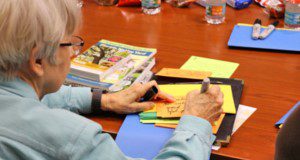Abstract
Extension is an important change agency, and Extension professionals use innovative strategies to help target audiences to adopt research-based practices and technologies. Tools from commercial marketing can be applied to behavior-change campaigns, often through an underused approach known as social marketing. Journey maps can be developed with Extension clients to provide insight into their progression and decision-making from one place or state of being to another. A journey can be the steps a person takes when selecting plants for the landscape, the decision-making process used when identifying agricultural business strategies, or the steps a person takes when leaving a workshop and travelling to their home. This new 9-page publication of the UF/IFAS Department of Agricultural Education and Communication, written by Colby Silvert and Laura A. Sanagorski Warner, presents possible applications of journey mapping within an Extension context.
http://edis.ifas.ufl.edu/wc333
References
Brahme, M. E., Gabriel, L., & Stenis, P. V. (2016). Don't stop believing: Mapping distance learners' research journeys. Journal of Library & Information Services in Distance Learning, 10(3-4), 118-136. doi:10.1080/1533290X.2016.1206779 https://doi.org/10.1080/1533290X.2016.1206779
Conroy, D. M., & Allen, W. (2010). Who do you think you are? An examination of how systems thinking can help social marketing support new identities and more sustainable living patterns. Australasian Marketing Journal, 18(3), 195-197. https://doi.org/10.1016/j.ausmj.2010.06.006
Cooner, D., & Dickmann, E. (2006). Assessing principal internships and habits of mind: the use of journey mapping to enhance reflection. Innovate: Journal of Online Education, 2(4). Retrieved from http://nsuworks.nova.edu/innovate/vol2/iss4/4
Crosier, A., & Handford, A. (2012). Customer journey mapping as an advocacy tool for disabled people: A case study. Social Marketing Quarterly, 18(1), 67-76. doi:10.1177/1524500411435483 https://doi.org/10.1177/1524500411435483
Crunkilton, D. (2009). Application review of journey mapping. Journal of Technology in Human Services, 27(2), 162-173. doi:10.1080/15228830902755879 https://doi.org/10.1080/15228830902755879
Esposito, M., & Zeledon, J. (2013). 5 ways you can use journey maps to help change behavior. Washington, D.C.: National WIC Association. Retrieved from https://www.nwica.org/blog/5-ways-you-can-use-journey-maps-to-help-change-behavior#.XOPvL_ZFyUk
Essen, A. V., Hersen, S., & Renes, R. J. (2016). Developing a theory-driven method to design for behaviour change: two case studies. Proceedings of the 2016 Design Research Society 50 Anniversary Conference, Brighton, UK. Retrieved from https://static1.squarespace.com/static/55ca3eafe4b05bb65abd54ff/t/5747666b60b5e9b8141bebe1/1464297071450/71+Van+Essen.pdf https://doi.org/10.21606/drs.2016.71
Howard, T. (2014). Journey mapping: A brief overview. Communication Design Quarterly Review, 2(3), 10-13. doi:10.1145/2644448.2644451 https://doi.org/10.1145/2644448.2644451
LeFebvre, C., Taylor, O., & Thomas, V. (2016, June). Aligning journeys, jobs, and value for more relevant and effective social marketing programs. Presentation at the University of South Florida Social Marketing Conference, Clearwater, FL.
Ortbal, K., Frazzette, N., & Mehta, K. (2016). Stakeholder journey mapping: An educational tool for social entrepreneurs. Procedia Engineering, 159(Humanitarian Technology: Science, Systems and Global Impact 2016, HumTech2016), 249-258. doi:10.1016/j.proeng.2016.08.170 https://doi.org/10.1016/j.proeng.2016.08.170
Panzera, A. D., Bryant, C. A., Hawkins, F., Goff, R., Napier, A., Schneider, T., … O'Rourke, K. (2017). Mapping a WIC mother's journey: A preliminary analysis. Social Marketing Quarterly, 23(2), 137154. doi:10.1177/1524500417692526 https://doi.org/10.1177/1524500417692526
Patterson, L., (2009). Managing Touch point value: 10 steps to improve customer engagement. Retrieved from https://www.visionedgemarketing.com/images/articles/managing%20touch%20point%20value%2010%20steps%20to%20improve%20customer%20engagement.pdf
Prochaska, J. O., DiClemente, C. C., & Norcross, J. C. (1992). In search of how people change: applications to addictive behaviors. American Psychologist, 47, 1102-1114. https://doi.org/10.1037/0003-066X.47.9.1102
Prochaska, J. O., Redding, C., & Evers, K. (1997). The Transtheoretical Model and stages of change. In K. Glanz, F. M. Lewis, and B. K. Rimer (Eds.), Health Behavior and Health Education: Theory, Research and Practice (2nd Edition). Jossey-Bass Publications, Inc.
Roarty, L., Wildy, H., Saggers, S., Conigrave, K., Wilson, M., Di Nicola, K., & ... Faulkner, J. (2012). 'My journey map': Developing a qualitative approach to mapping young people's progress in residential rehabilitation. Contemporary Drug Problems: An Interdisciplinary Quarterly, 39(4), 715-733. doi:10.1177/009145091203900406 https://doi.org/10.1177/009145091203900406
Rogers, E. M. (2003). Diffusion of Innovations (5th edition). New York, NY: Free Press.
Stern, P. C., & Wolske, K. S. (2017). Limiting climate change: What's most worth doing? Environmental Research Letters, 12(9). doi: 10.1088/1748-9326/aa8467 https://doi.org/10.1088/1748-9326/aa8467
Tassi, R. (2009). Customer Journey Map. Service design tools. Retrieved from http://www.servicedesigntools.org/tools/8
Warner, L., Galindo-Gonzalez, S., & Gutter, M. S. (2014). Building impactful extension programs by understanding how people change. University of Florida Cooperative Extension Electronic Data Information Source (AEC527). Retrieved from http://edis.ifas.ufl.edu/wc189
Westbrook, J. I., Coiera, E. W., Gosling, S. A., & Braithwaite, J. (2007). Critical incidents and journey mapping as techniques to evaluate the impact of online evidence retrieval systems on health care delivery and patient outcomes. International Journal of Medical Informatics, 76(2-3), 2007, 234-245. doi:10.1016/j.ijmedinf.2006.03.006 https://doi.org/10.1016/j.ijmedinf.2006.03.006
Unless otherwise specified, articles published in the EDIS journal after January 1, 2024 are licensed under a Creative Commons Attribution-NonCommercial-NoDerivs 4.0 International (CC BY-NC-ND 4.0) license.


